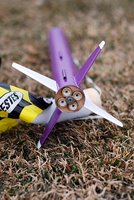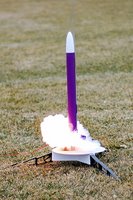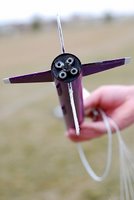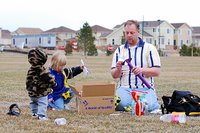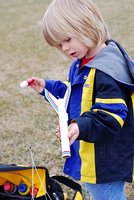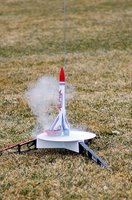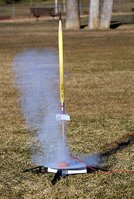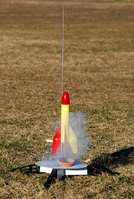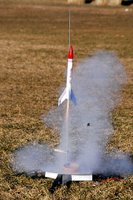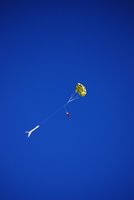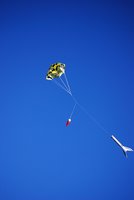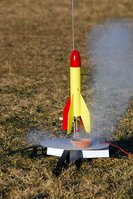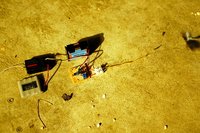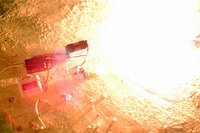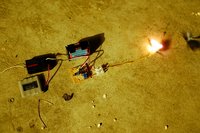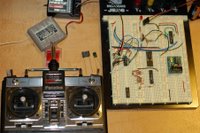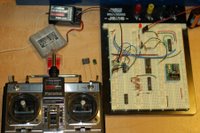Monday, May 28, 2007
Launch Log 2007.05.28
The first launch was Might Mouse I with an A8-5. The Mighty Mouse is good to fly on a C, but I wanted to start with an A to introduce the girls to rockets. I think we should stick to A8-3 or just go with B or bigger in the future because the 5 second delay put the chute opening about 16 feet above ground (I was nervous).
Our second launch was the recently completed SpaceShip ONE. We used an A8-3, but that didn't work out so well. I think we'll try it again on a C, but I may not have gotten the wings straight because this launch was just kart-wheeling off the rod. We did a first flight of the UNNAMED: it flew decent and then melted the chutes on deployment. It recovered fine (fortunately, one of the chutes fully opened), but I'll have to figure out how to properly pack the chutes.
We finally launched the Alpha and the Outlaw. Both had great flights. The Alpha flew on a C6-7 and the Outlaw flew on a C6-5. Both were recovered in the same field, thanks to the calm weather. The paint on the Alpha is bubbled, so Luke and I suspect that the heat is causing it some problems. We may have to retire this one and get a new one for future flights.
Thursday, May 24, 2007
Alberto Santos-Dumont
It was while I was looking for information about personal blimps that I saw Alberto's name. I was reading the FAQ about the Alberto airship from SkYacht and they pointed out that they named the ship after this pioneer of aviation.
Isn't it beautiful:

Saturday, March 10, 2007
Launch Log 2007.03.10
Today was our first time launching a cluster. This one was the FlisKits Rhino with a 4-motor cluster built with centering rings from Jon's Colorado Rocketry Components.
The Rhino had two flights and both were amazing. The first flight was on 4 A3 motors and the rocket proved to flight straight. I did a quick clean-up, regreased, reloaded, and took a second flight with 4 A10's.
After flying the Rhino, we flew Isaac's Alpha on a C6-7... we were sure we lost the rocket because there was no sight of it even a couple minutes after the launch. While Spencer and I were over in the field to the east of the launch field, we noticed the Alpha decending over the field to the south of the launch field. Wowsers - we'll have to get a pico altimeter and beacon installed in the Alpha before another flight on a C motor!
Monday, March 05, 2007
Launch Log 2007.03.04
We had a beautiful day for a launch at the school by our house today. It was a little breezy, so we started the launch with a C6 in the Outlaw to get an idea what to expect. It was a very pretty flight because the motor was extra smoky and went nice and high.
Those were the last launches of Pipes and Pencil: Pipes got tangled up in power lines and I have no idea when the power company will get it down and I doubt they'll bring it to us; Pencil was flying without a chute (because we forgot all of our chutes at home) and it turns out it doesn't do tumble-recovery so well. BTW, Pipes and Outlaw do tumble-recovery perfectly.
Shanelle went home to get chutes and then we were able to fly some more. Isaac did the prep on his Alpha rocket from Seth. The Alpha had a nice launch, but on its first flight the chute was tangled so it bounced.
Afer the Alpha launch, Spencer decided he was ready to launch his rocket from Seth - the Mighty Mouse. Mighty Mouse flew a couple times and as always it flew beautifully.
The flight was great, but got a little scary because it looked like it was coming down in a tree. It must have been just past the tree or flew through the branches.
The Alpha taking a second flight - the recovery pictures are interesting because we replaced the usual rubber shock-cord with Kevlar thread. The thread is often used in contest models because it is light.
Spencer did the count-down and pushed the button on 3 launches: 1 launch of the Pencil and 2 launches of the Mighty Mouse. He even recovered Mighty Mouse after its second flight.
Saturday, March 03, 2007
March Launch Scrubbed

Above is a picture of the rockets that I took with me to the launch. I had expected to make my first high-power flight with the bullet today. While I didn't get to fly, I did get a chance to ask another club member to look over the rocket. The red and yellow is an Estes Baby Bertha kit that we've named Mighty Mouse - I actually took two of those today: one with a since 18mm motor mount and one with a cluster of 3x13mm motor.
Tuesday, January 30, 2007
The Astronaut Farmer
There was a point in the movie where there is a failure and I was horrified: I thought that the BATFE had worked with the Polish Brothers to help the public see the 'light' on their current case affecting rocket propellant and ignitors used by hobbyists. In the movie, it is the FBI rather than the BATFE, but a similar idea (Farmer was fine building his rocket - it was when he attempted to buy fuel that he got into trouble - even though he had attempted to follow known regulations).
There is a lot of family focus in the movie - the kind that I like because it helps me consider my role as a parent and gives me some things to think over. Some details are ignored - again, a nice thing - for example, Farmer allows the public to come into his garage and see the rocket and the line goes on for miles (apparently, these were only the most well behaved humans on the planet because there was no mess and no fights). I believe that the movie was filmed in New Mexico - I only mention it because the house, the ranch, etc. were so pretty that they really complimented the story / experience.
Good stuff.
Monday, January 29, 2007
Feb launch scrubbed but...
Friday, January 19, 2007
building a few cluster models
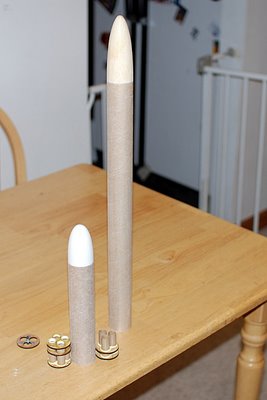
Both rockets use BT-60 size tubes, so I picked up a couple cluster mounts from a local rocket guy. The Baby Bertha will use 3 tiny A motors and the Rhino will use 4; this will give the Baby Bertha about 6.6 N-s and the Rhino 8.8 N-s of total impulse (equivalent of mid-C).
Wednesday, January 03, 2007
Jan 6 launch scrubbed
- from http://www.ncrocketry.org/
Regrettably but sensibly, NCR will NOT attempt to launch on Saturday the 6th. Our equipment trailer remains buried in deep snowdrifts and is pretty much in-accessible, as is the Atlas Site.
Tuesday, December 26, 2006
preparing for first Bullet flight
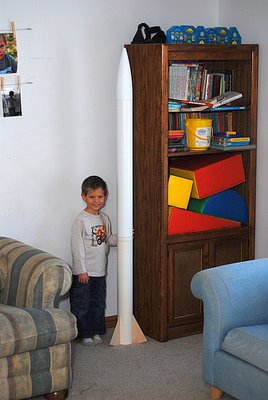
In this picture, the base kit has had an avionics bay and an extension added. The avionics bay will carry the electonics that Michael and I have been working on. The extension is simply there to connect the avionics to the nose cone, but the additional length helps the rocket fly stably with heavy tail.
One last bit (besides the finishing of the rocket) is to test fire a motor. I'll be using a reloadable motor system and I need to verify that I can safely assemble and fire the engines without it blowing up or failing to fire the ejection :)
Thursday, December 21, 2006
some individuals weights
- 1200 lbs quick link - almost exactly 1 oz
- 800 lbs quick link - about 1/2 oz
- 660 lbs quick link - about 1/3 oz
- 16 ft kevlar - about 3/4 oz
It's kinda funny that I differentiate between 1/2 and 1/3 because my scale isn't that precise, but that's the way I read it.
Saturday, December 16, 2006
device direction
Michael has gathered some great links. We'll likely consider where we want to be in the longer term (guidance) and see if one of the product families fit better than the other.
Wednesday, December 13, 2006
testing R/C with an igniter
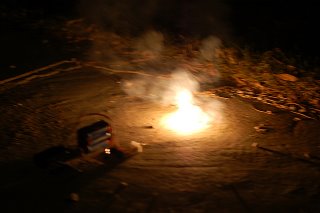
In the first attempt, I took the pictures and I am all sorts of no good at taking pictures. Shanelle assisted in the second attempt by taking some excellent pictures. I hooked everything up and told Shanelle what to expect and then flipped the switch.
It takes about 3 seconds for the igniter to get hot enough to fire. I'm just using a 6 cell AA pack of NiMH batteries. The total voltage is 8.4 volts - quite a bit lower than the preferred 12 volts. It's nice that the igniters were willing to give me joy on the 8.4.
Tuesday, December 12, 2006
another post about the R/C backup circuit
The difference between the two images above is the position of the gimble. Turning the LED on when using the 1% capacitor takes 1 click at the center of the throw. When I use the black box capacitor, it takes 2 clicks about 2/3 up in the throw. When using the green capacitor, it takes 2 clicks at the center. After 1 click from off, the lower precision capacitors flicker. Of course, in real action, I'll use the switch (top left of the controller), but the gimble adjustment seems like a good test to see where the circuit is sensitive.
I feel good about the reliability of the circuit and parts availability, so it is time to solder a version together and test the first circuit with some higher current. The yellow capacitors are expensive at 30 cents each, but not prohibitively expensive - I think that I'll start with those and I'll use the Motorola 4013 since I have more of those than the SGS. The firing mechanism is currently using an IRF 531, which are locally available, so I'll be putting that into the initial prototype.
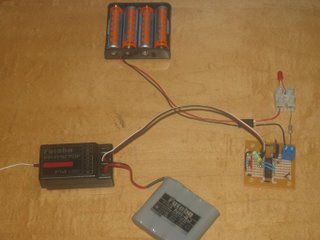
Saturday, December 09, 2006
all power
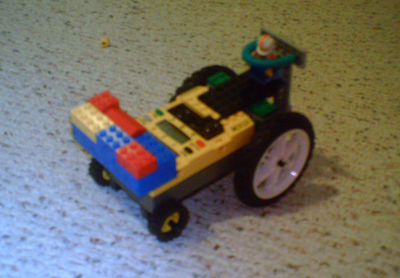
Note that this was taken with the boys' camera... it isn't a Canon / Nikon thing.
Thursday, December 07, 2006
XM Radio Constellation
Well, the XM Radio wikipedia entry has lots of great info, but it wasn't immediately obvious how big their constellation is or current orbits. While searching around, I bumped into the decode systems page which led me to VITA.
I know nothing about VITA - perhaps they are scum; however, the interesting bit to me is that there is a group of volunteers that have a license for a satellite constellation. Interesting. Serendipity do day.
great capacitor resources
R/C Backup Recovery

I attempted to build this similar circuit, but didn't have all the parts necessary. I got some variance where the transistor would be when I moved the gimble, but I wasn't able to complete the circuit to drive a MOSFET or anything. I like the 4013 circuit because it worked first time and is now my circuit.
This excellent page gave us a lot of good information about the way the receiver is communicating with the servos. I would have liked to build the circuit they use, but the local electronics store was out of both the 74HC123 and 74HC74! It isn't worth $5 in shipping to get $1.28 in parts, so I think I'll put off building this one until some other time.
Monday, December 04, 2006
nanotubes to diamonds
Diamonds are three-dimensional crystals of pure carbon. Two-dimensional carbon is graphite, while nanotubes are considered a one-dimensional form of pure carbon. (Technically, graphite and nanotubes have three dimensions, but the Z axis on graphite and the Z,Y axes on nanotubes are so small that they become irrelevant.)- from a news.com article
Saturday, December 02, 2006
my first SMD solder attempt

My strategy was to tack the chip down on pins 1 and 18. That turned out to be more difficult than I had anticipated: when I'd get the solder soft to move the chip for alignment, I'd repeatedly move it too far. I finally got it aligned and then soldered all pins in a rough fashion - just making sure I got a good bead on each lead and it flowed under the PIC leads. After everything had some solder on it, I used a fine desolder braid briefly on each lead to pull up the bridges.
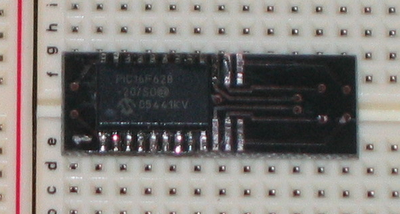
After everything was soldered, I tested by poking each pin to see if it moved. None did. Then I put the PIC / adaptr into the bread-board to check resistance. I had an initial scare when I hit Vcc, but then I realized that would probably be okay. I'm looking forward to trying out a circuit now.
